USS Accelerate (ARS-30) was a salvage ship in the service of the United States Navy.

USS Fearless (AM/MSO-442) was an Aggressive-class minesweeper. She was the third United States Navy ship to carry the name.

Merritt-Chapman & Scott, nicknamed "The Black Horse of the Sea", was a noted marine salvage and construction firm of the United States, with worldwide operations. The chief predecessor company was founded in the 1860s by Israel Merritt, but a large number of other firms were merged in over the course of the company's history. It was taken over in the 1950s by famed corporate raider, Louis E. Wolfson. It went into liquidation in 1967.
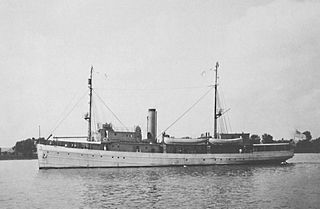
USS Osprey (AM-29) was an Lapwing-class minesweeper commissioned by the United States Navy for service in World War I. She was responsible for removing mines from harbors, and, in her role as rescue and salvage ship, she was responsible for coming to the aid of stricken vessels. After service in the United States Coast and Geodetic Survey as the survey ship USC&GS Pioneer, she returned to the U.S. Navy in 1941 as the salvage ship USS Crusader (ARS-2), serving as such through the end of World War II.

USS Oriole (AM-7) was a Lapwing-class minesweeper acquired by the U.S. Navy for the dangerous task of removing mines from minefields laid in the water to prevent ships from passing.

USS Woodcock (AM-14) was an Lapwing-class minesweeper acquired by the United States Navy for the dangerous task of removing mines from minefields laid in the water to prevent ships from passing.
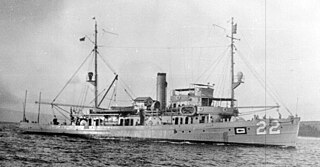
USS Widgeon (AM-22/ASR-1) was an Lapwing-class minesweeper acquired by the United States Navy for the dangerous task of removing mines from minefields laid in the water to prevent ships from passing. Later converted to a submarine rescue ship. Widgeon was named by the Navy after the widgeon, a freshwater duck.

USS Brant (AM-24) was a Lapwing-class minesweeper in the United States Navy during World War II. She was named by the U.S. Navy for the brant, a small goose.

USS Redwing (AM-48) was an Lapwing-class minesweeper commissioned by the United States Navy for service in World War I. She was responsible for removing mines from harbors, and, in her role as rescue and salvage ship, she was responsible for coming to the aid of stricken vessels. She was laid down 5 August 1918 by the Baltimore Drydock & Shipbuilding Co., Baltimore, Maryland; launched 7 June 1919; sponsored by Mrs. Fred A. Plagemann, wife of the prospective commanding officer; and commissioned 17 October 1919.

USS Flamingo (AM-32) was a Lapwing-class minesweeper built for the United States Navy near the end of World War I. After service overseas clearing mines after the Armistice, the ship was laid up until 1922 when she was transferred to the United States Department of Commerce for use by the United States Coast and Geodetic Survey. Renamed USC&GS Guide, the ship operated as a survey vessel along the West Coast of the United States for 17 years, making significant contributions to navigation, hydrographic surveying, and oceanography. In June 1941, Guide was transferred back to the Navy, converted into a salvage ship, and renamed USS Viking (ARS-1). As Viking, she worked primarily from bases in California until 1953, when she was sold for scrapping.
Rescue and salvage ships are a type of military salvage tug. They are tasked with coming to the aid of stricken vessels. Their general mission capabilities include combat salvage, lifting, towing, retraction of grounded vessels, off-ship firefighting, and manned diving operations. They were common during World War II.
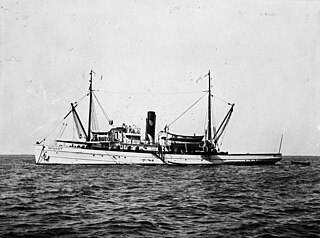
USS Willet (AM-54) was a Lapwing-class minesweeper commissioned by the United States Navy for service after World War I. Willet's task was to clear mines from minefields laid in combat areas by enemy forces.
USS Harjurand (ARS-31) was a rescue and salvage ship acquired by the U.S. Navy during World War II. Her task was to come to the aid of stricken vessels.
USS Gear (ARS-34) was a Diver-class rescue and salvage ship acquired by the U.S. Navy during World War II. Her task was to come to the aid of stricken vessels.

USS Auk (AM-38) was a Lapwing-class minesweeper acquired by the United States Navy after World War I to remove mines that had been placed during the war.
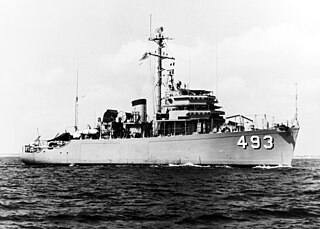
USS Stalwart (MSO-493) was an Agile-class minesweeper acquired by the U.S. Navy for the task of removing mines that had been placed in the water to prevent the safe passage of ships.
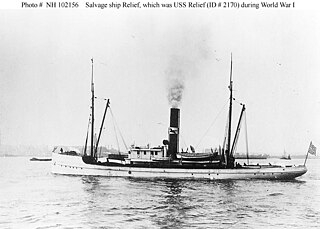
USS Relief (SP-2170) was a salvage tug that was built in Delaware in 1907 and scrapped in 1953. She served in the United States Navy in the First World War from 1918 to 1919, and provided civilian support to the Navy in the Second World War from 1942 to 1945. She belonged to the Merritt & Chapman Derrick & Wrecking Co, which in the 1920s became Merritt-Chapman & Scott. She rescued the steam yacht Warrior in 1914, and survived a collision with a US Navy patrol vessel in 1918.

USC&GS Pioneer was a survey ship that served in the United States Coast and Geodetic Survey from 1922 to 1941. She was the first ship of the Coast and Geodetic Survey to bear the name.

The first USC&GS Discoverer was a survey ship that served in the United States Coast and Geodetic Survey from 1922 to 1941.
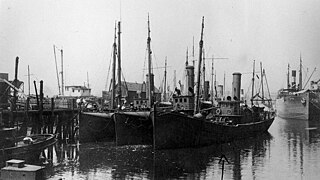
The second USS Ripple (ID-2439) was a United States Navy trawler which served as a minesweeper and was in commission from 1918 to 1919.















